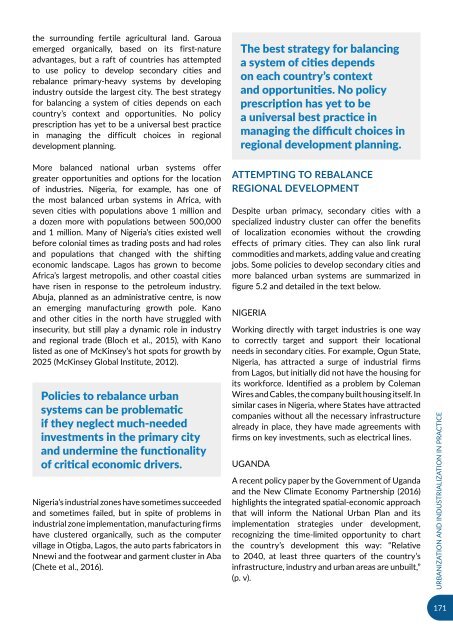URBANIZATION AND INDUSTRIALIZATION
Economic%20Report%20on%20Africa%202017%20UNECA
Economic%20Report%20on%20Africa%202017%20UNECA
Create successful ePaper yourself
Turn your PDF publications into a flip-book with our unique Google optimized e-Paper software.
the surrounding fertile agricultural land. Garoua<br />
emerged organically, based on its first-nature<br />
advantages, but a raft of countries has attempted<br />
to use policy to develop secondary cities and<br />
rebalance primary-heavy systems by developing<br />
industry outside the largest city. The best strategy<br />
for balancing a system of cities depends on each<br />
country’s context and opportunities. No policy<br />
prescription has yet to be a universal best practice<br />
in managing the difficult choices in regional<br />
development planning.<br />
The best strategy for balancing<br />
a system of cities depends<br />
on each country’s context<br />
and opportunities. No policy<br />
prescription has yet to be<br />
a universal best practice in<br />
managing the difficult choices in<br />
regional development planning.<br />
More balanced national urban systems offer<br />
greater opportunities and options for the location<br />
of industries. Nigeria, for example, has one of<br />
the most balanced urban systems in Africa, with<br />
seven cities with populations above 1 million and<br />
a dozen more with populations between 500,000<br />
and 1 million. Many of Nigeria’s cities existed well<br />
before colonial times as trading posts and had roles<br />
and populations that changed with the shifting<br />
economic landscape. Lagos has grown to become<br />
Africa’s largest metropolis, and other coastal cities<br />
have risen in response to the petroleum industry.<br />
Abuja, planned as an administrative centre, is now<br />
an emerging manufacturing growth pole. Kano<br />
and other cities in the north have struggled with<br />
insecurity, but still play a dynamic role in industry<br />
and regional trade (Bloch et al., 2015), with Kano<br />
listed as one of McKinsey’s hot spots for growth by<br />
2025 (McKinsey Global Institute, 2012).<br />
Policies to rebalance urban<br />
systems can be problematic<br />
if they neglect much-needed<br />
investments in the primary city<br />
and undermine the functionality<br />
of critical economic drivers.<br />
Nigeria’s industrial zones have sometimes succeeded<br />
and sometimes failed, but in spite of problems in<br />
industrial zone implementation, manufacturing firms<br />
have clustered organically, such as the computer<br />
village in Otigba, Lagos, the auto parts fabricators in<br />
Nnewi and the footwear and garment cluster in Aba<br />
(Chete et al., 2016).<br />
ATTEMPTING TO REBALANCE<br />
REGIONAL DEVELOPMENT<br />
Despite urban primacy, secondary cities with a<br />
specialized industry cluster can offer the benefits<br />
of localization economies without the crowding<br />
effects of primary cities. They can also link rural<br />
commodities and markets, adding value and creating<br />
jobs. Some policies to develop secondary cities and<br />
more balanced urban systems are summarized in<br />
figure 5.2 and detailed in the text below.<br />
NIGERIA<br />
Working directly with target industries is one way<br />
to correctly target and support their locational<br />
needs in secondary cities. For example, Ogun State,<br />
Nigeria, has attracted a surge of industrial firms<br />
from Lagos, but initially did not have the housing for<br />
its workforce. Identified as a problem by Coleman<br />
Wires and Cables, the company built housing itself. In<br />
similar cases in Nigeria, where States have attracted<br />
companies without all the necessary infrastructure<br />
already in place, they have made agreements with<br />
firms on key investments, such as electrical lines.<br />
UG<strong>AND</strong>A<br />
A recent policy paper by the Government of Uganda<br />
and the New Climate Economy Partnership (2016)<br />
highlights the integrated spatial-economic approach<br />
that will inform the National Urban Plan and its<br />
implementation strategies under development,<br />
recognizing the time-limited opportunity to chart<br />
the country’s development this way: “Relative<br />
to 2040, at least three quarters of the country’s<br />
infrastructure, industry and urban areas are unbuilt,”<br />
(p. v).<br />
<strong>URBANIZATION</strong> <strong>AND</strong> <strong>INDUSTRIALIZATION</strong> IN PRACTICE<br />
171


